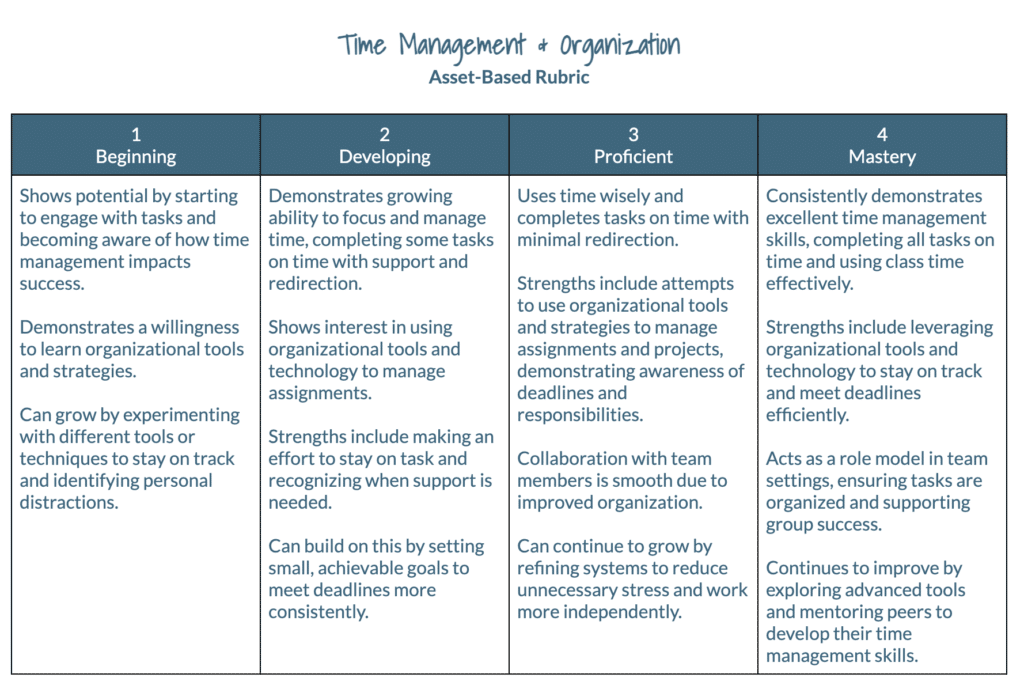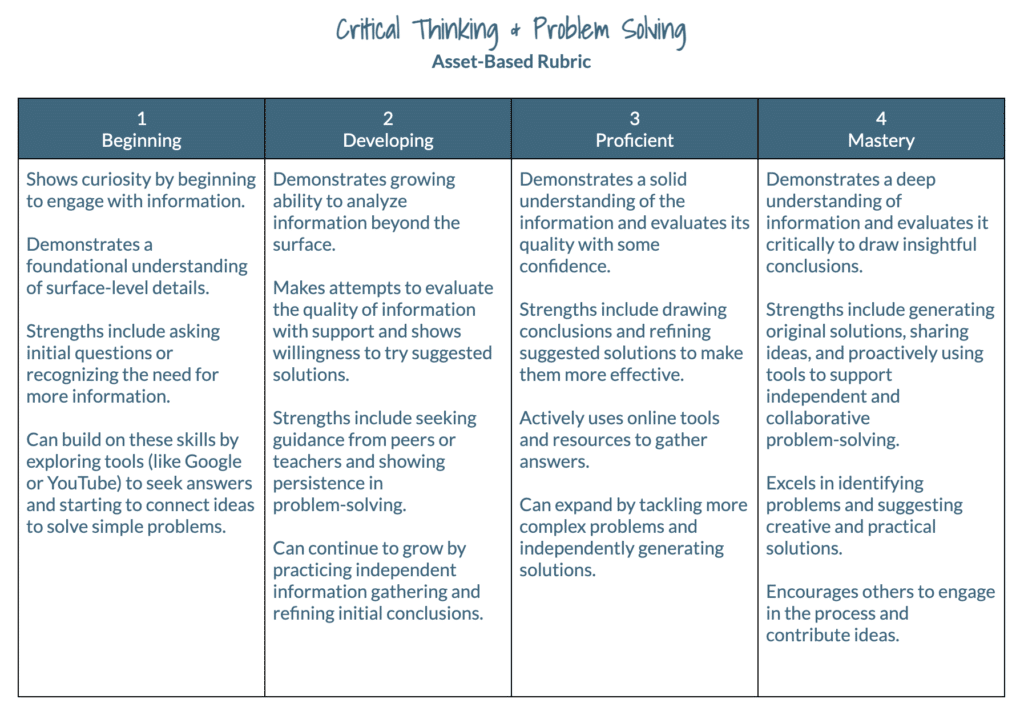The world of work is shifting faster than ever. As technology and automation continue to reshape industries, the ability to adapt, collaborate, and think creatively has become more important than ever. In fact, the Bureau of Labor Statistics reports that the average worker now holds more than 12 different jobs before the age of 50. That kind of career mobility demands flexibility, problem-solving, and the kind of soft skills that make people indispensable in a workplace that’s always evolving.
But here’s the thing: these critical skills don’t just develop on their own. Many students haven’t been explicitly taught how to communicate effectively, manage their time, or tackle unfamiliar challenges. That’s where we, as educators, step in. We can’t assume students know what these skills look like or how to practice them. It’s our job to intentionally teach and assess them, just like we do with academic content.
Explicitly Teaching Soft Skills
This year, I’ve been focusing on teaching and assessing essential soft skills in my classroom. I started by identifying the skills I believe are most valuable—time management, communication, collaboration, creative problem-solving, and flexibility. Then I created rubrics to help students understand what these skills look like in action and where they can grow. These rubrics aren’t just about evaluation; they’re tools to help students reflect, set goals, and see their progress over time.
In our project-based program, these skills are as essential as academic knowledge. Tackling large-scale projects, working with diverse team members, and overcoming challenges require students to think and act beyond content mastery. That’s why my team and I use these rubrics to give students specific, actionable feedback that supports their success—not just in school, but in life.
Designing Rubrics to Assess Soft Skills
Below, you’ll find some of the rubrics I designed to guide this work. Feel free to click on the images, make a copy, and adapt them for your students. I hope they’re as helpful for your classroom as they’ve been in mine!



The Benefits of Assets-Based Rubrics
Shifting to asset-based rubrics changes the conversation about learning. Instead of focusing on what students can’t do, these rubrics highlight their strengths and help them see where they’re growing. This subtle shift has a big impact, especially when students use these tools for self-assessment. By emphasizing what students are doing well, we encourage them to reflect on their progress, set goals, and approach their learning with confidence. They’re no longer stuck in a mindset of “I’m bad at this,” but instead, they can think, “Here’s where I’m doing well, and here’s my next step.” It’s about moving forward, not getting stuck in what they lack.
When we frame rubrics this way, we’re fostering a growth mindset. Students see themselves as capable and developing, which makes self-assessment less intimidating and more empowering. They’re able to take ownership of their learning because they can identify their strengths and use them as a foundation to keep improving. This is so important when it comes to skills like collaboration, communication, and problem-solving—skills that aren’t fixed but evolve with practice.
Asset-based rubrics also help reduce the shame or defensiveness that can come with traditional deficit-based feedback. When feedback feels like a judgment, students naturally shut down or become resistant. But when we highlight what’s working, students feel supported and safe to acknowledge areas for growth. This makes the feedback process collaborative rather than punitive, helping students stay engaged and motivated to improve.
Another benefit is how these rubrics align with inclusive practices. Every student brings different strengths to the table, and growth doesn’t look the same for everyone. Asset-based rubrics honor that variability. They celebrate what each student contributes, no matter where they’re starting from. This approach helps create a classroom culture where progress is the goal and everyone feels valued.
Ultimately, asset-based rubrics are about modeling the kind of feedback we want students to give and receive—not just in school, but in life. They encourage students to focus on growth and improvement rather than perfection, which supports both academic development and social-emotional learning. When students feel empowered to see their potential and build on it, they develop confidence, resilience, and self-awareness—skills they’ll carry with them well beyond the classroom.


44 Responses
[…] Teaching & Assessing Soft Skills. The career landscape is changing dramatically. The Bureau of Labor Statistics states that the average worker currently holds ten different jobs before the age of forty. This requires a high degree of flexibility and adaptability. Students who leave high school with strong soft skills will work more harmoniously with others and be more successful tackling unfamiliar tasks. However, teachers must explicitly teach these soft skills in school. This year I am focusing on both teaching and assessing these critical soft skills. Now my teacher team uses these rubrics to give each student feedback on where he/she is in relation to mastering these crucial skills. […]
[…] Who Controls The Flow Of Information In Your Classroom? – Teaching & Assessing Soft Skills. […]
Very useful rubrics. Thank you for sharing.
You’re welcome, Ikram.
Catlin
Hi Caitlin. How do I get s hold of your work? It
Might be something I could use with my students.
Hi Patricia,
Are you asking about the books I’ve written? If so, you can search my name on Amazon and they are all sold there. If you are looking for something else, let me know!
Catlin
Hi Caitlin,
Thanks for sharing your rubrics, so detailed!
ciao
Nives
Hi Catlin,
OOps sorry I mispelled your name!
Nives
No problem 🙂
Thanks Catlin,
I agree these skills are important and are not just gained by osmosis! I wonder what further impact the rubrics would have if they focused on what students do demonstrate instead of what they don’t (in some instances) making them more of a continuum and thus recognising the progressive nature of learning and coming from a positive presupposition.
Very helpful – thank you for sharing !!
I find collaboration in a team a tricky one to assess in terms of leadership – that tends to be something we look for and value, yet if everyone tried to lead a group, it would break down quickly. Sometimes the “worker bees” are underrated, but I try to praise those who could lead, but also know when it is time to just do the work and follow directions. I think you get at that with “multiple roles”, but sometimes their only role THAT day is worker or leader. That is why it is important to regularly assess collaboration (and even have students self assess!) Thanks for sharing your excellent rubrics!
Very useful indeed. I’ve spent my career in higher education, and I feel that this is applicable to students studying for degree level qualifications. For quite some time, I have used ‘soft skill’ development exercises in my own teaching as an add-on to the more technical, subject-specific aspects of learning programmes, and it has generally been well received by students. From my perspective, I think soft skills are key to effective learning, and I applaud the approach used here.
Wonderful! Thank you!
[…] Some apps can be used as graphic portfolios or as beautiful sketchbooks, others are great at sharing. Not all of the apps available are great at all of these things. I have spent a heap of time trying to find one and would be more than happy for someone to send me the name of one they are using successfully. Having said that the following are apps that I would consider using; Evernote: FREE Evernote is an easy-to-use, free app that helps you remember everything across all of the devices you use. Paper: FREE Paper is an easy and beautiful way to create on iPad. Teaching & Assessing Soft Skills. […]
Hi Catlin from Perth, Australia. Thank you for sharing these thoughtful and detailed rubrics. Our students work online in a shared platform, so we are particularly interested in your rubric on Online Communication. This is a terrific resource that will prompt a lot of discussion from both educators and students!
Kathy
Hi Kathy,
I’m so glad you can use these with your students in Perth! If you know any teachers in Perth who want to connect with a class in California, let me know!
Catlin
Hi Catlin,
I’ve followed your work for years. Thanks for these great rubrics. Our department uses something similar based on the Microsoft ITL 21CLD Rubrics. (See our website below.) We use this with teachers on their lesson design. Keep doing your good stuff!
Terra
Thank you, Terra!
I’m glad your department is also using this approach. I’d love to see more people prioritize soft skills.
Take care.
Catlin
Could I get these rubrics emailed
No, but you can log into your Gmail and make copies of them.
Catlin
Thanks for sharing Catlin. Very helpful
Thank you for sharing these. Particularly interested in your approach to building skills, if you’re ever looking for a connection in N Ireland, let me know!
Juliette, Derry, NI
Hi Juliette,
During college, I lived in Cork and worked at a coffee shop on St. Patrick Street! I’d love to connect classrooms! What age group do you teach?
Catlin
Excellent! We are an all girls school with students from 11-18, take a look http://www.stceciliascollege.com
[…] another post, Tucker discusses the work she is doing to teach and assess soft skills including communication and […]
Hello, I am looking for a curriculum for soft skills…any recommendations? Thank you so much,
I don’t have a recommendation, Michelle. I’ve created everything I use, but maybe someone else will have a recommendation for you.
Catlin
First of all, I think you’re wonderful Catlin! My husband teaches in Lodi and I’m so jealous whenever he gets to participate in one of your PD sessions! Michelle-I just came across these rubrics because someone posted the link in the comments of the breakoutedu.com fb page. A lot of these skills are addressed in breakouts (both physical and digital breakouts). I love doing the breakouts with students and think the range of skills they require so useful – a lot of these soft skills. Check it out! Oh, yeah-all the digital breakout games games are free!
Thank you for your kind words and for sharing this resource, Marcy!
Catlin
[…] Caitlin Tucker’s Soft Skills Rubrics: http://cluttered-record.flywheelsites.com/2017/09/teaching-assessing-soft-skills/ […]
Hi Caitlin,
I follow your blog and have gotten a lot of great ideas to use in the classroom – or that have challenged my current thinking. I don’t think anyone can argue that it is extremely beneficial for students to develop critical thinking – not to mention the ability to collaborate and communicate effectively. However, I have to disagree with you on the approach to explicitly teach these “soft skills” independent of content knowledge. I believe these skills should be embedded in a strong curriculum based on content. In my 16 years of experience in the classroom, I have come to realize that quite simply, students don’t know stuff. Now, I realize this statement is quite generalized – however, year after year, more of my students come to me in 8th grade lacking background knowledge that would otherwise allow them to think critically. Especially in the age of Google, students feel they don’t need to know things – and the focus on “soft skills” is, in my opinion – making kids less and less knowledgeable about the world around them. So, I think teaching the skills independently will not produce an informed citizenry, in fact, many cognitive scientists wpould argue you can’t teach these skills.
https://www.aft.org/sites/default/files/periodicals/Crit_Thinking.pdf
Hi Brian,
I appreciate your perspective. I don’t think soft skills should be taught or cultivated in isolation removed from curriculum or grade level skills. My concern is that there is not enough focus on developing soft skills. My goal is to explicitly teach but it is almost always in the context of our curriculum. When they practice communication skills it is in discussions about the literature we are reading or the presentation of a project to a panel. Same with the ability to collaborate. Those skills are practiced and honed in their work as a team member in a design thinking challenge or project. I did not mean to suggest they are taught without any link to the curriculum. I feel that the development of these critical soft skills enhance their ability to succeed academically when it comes to understanding curriculum and mastering academic skills.
Catlin
[…] La rétroaction 101 Pourquoi apprendre à donner de la rétroaction efficacement? Nous savons que la rétroaction fonctionne. En outre, certains types de rétroaction sont plus efficaces, pertinents que d’autres. 1. 2. 3. 4. Teaching & Assessing Soft Skills. […]
Hi Catlin,
Check out this e-learning Soft Skills program(link below). I teach high school business in Michigan. My students go through one of these a week on “Employability Wednesday”. They then do a self analysis blog post in their e-portfolio. Students actually really like these. Good stuff. It’s also “Dress for Success” day where they wear interview appropriate attire(optional). Since athletes dress up on game days….why not have business students have a “game day”? It brings attention to my program and the kids have a reason to dress up. Check it out.
https://www.mitalent.org/elearning-soft-skills-program
Dorthy
Hi Catlin,
What do you provide students in terms of dos and don’ts of online etiquette instruction? Thank you!
Hi Carolyn,
I’ve got a formal “Dos and Don’ts for Online Communication” that is in my first book Blended Learning in Grades 4-12. That book focuses on creating a safe space online, establishing clear expectations for communication and engagement, building a strong online community to complement class time, teaching students to say something substantial online, designing dynamic online discussion questions, then weaving that work back into the classroom. That might be a useful resource as you embark on online work with students.
[…] some idea where they’re going and what they expect to do in life but few have really written Teaching & Assessing Soft Skills an official mission statement. Knowing the focal point can help you fully grasp the significance of […]
[…] best if it is possible to express your thesis within a sentence placed at the conclusion of Teaching & Assessing Soft Skills the introductory […]
I love what you have written about soft skills; it’s exactly what I speak of with the kids I work with. I have recently obtained a workbased learning endorsement, and am working to get students placed in work situations.
Hello Catlin,
Thank you for your sharing. I’m about to check my students’ 4C skill after some mathematical practice. Your rubrics are really useful for this matter.
As you said you also focus on Creativity skill, can I please have the rubric for that.
Alternatively, how can I get the full version rubrics that you designed?
Thank you : )
Caitlin,
These are great. Thanks for sharing. These will be helpful for me, as I’m teaching a course for high school students with disabilities this summer using Zoom.
–Randy Mahoney Jr.
Hi Catlin,
thanks for this post, that’s exactly what I’ve been struggling to find. Have you also made a rubric on “managing someone’s time” as you write? I would find usefull to read it. Thank you, Zuzana
Hi Zuzana,
I have not seen a rubric specifically on that, though it does remind me of the soft skill rubrics I developed. Below is one I created on time management and organization, which may be helpful.
https://docs.google.com/document/d/1Z2OdTvl3Jh8kQvMc9HCG3YbZyibXkMLCNF4yW80P9no/edit
I hope you can use or modify that!
Take care.
Catlin